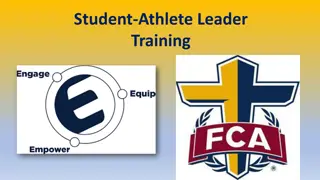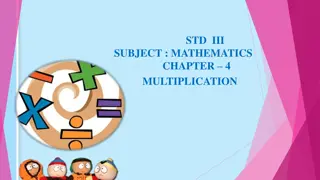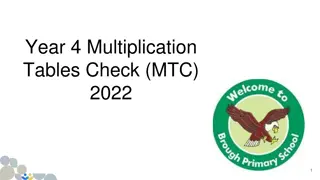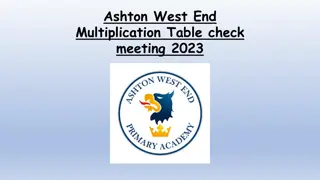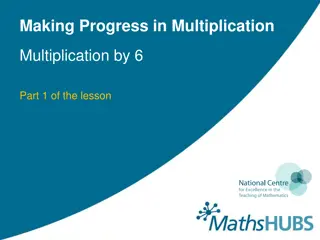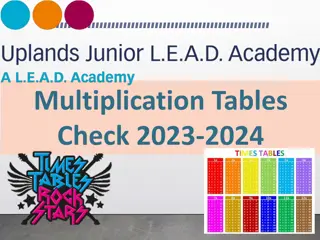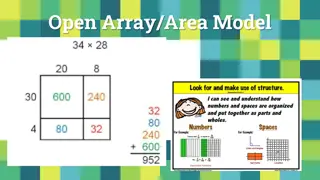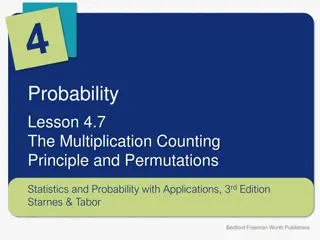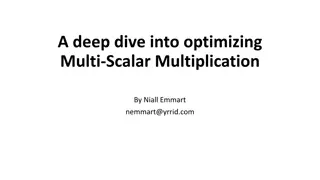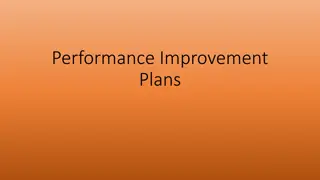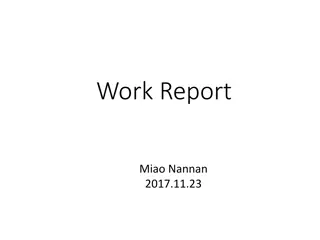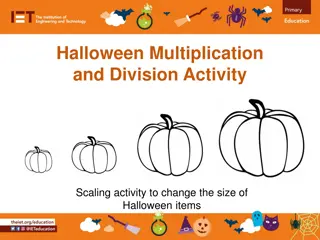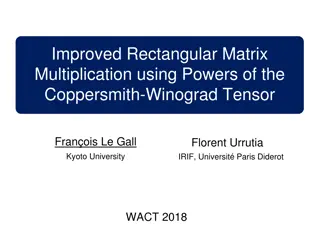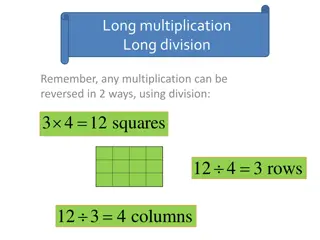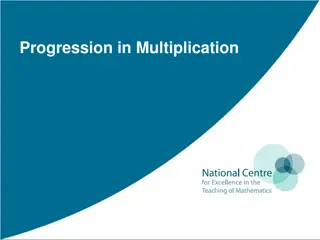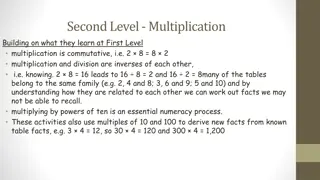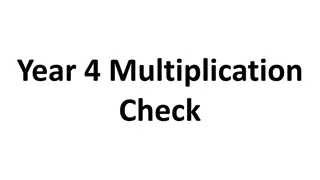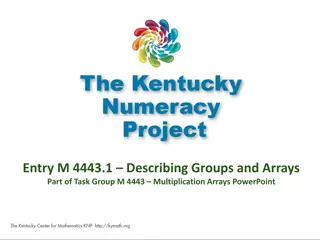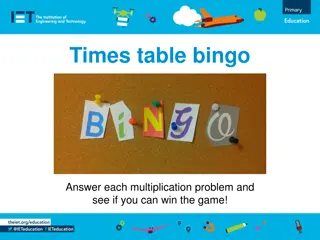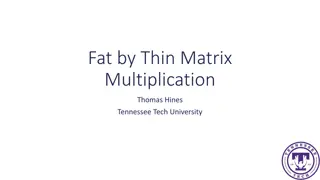Advanced Techniques for Multiplication Performance Improvement
Explore advanced methods to enhance multiplication performance by utilizing shifts and add/subtract operations instead of traditional arithmetic. The solutions provided involve hexadecimal number pairs, demonstrating the best ways to calculate products efficiently. Furthermore, a challenge is presented to write an MIPS assembly language program for multiplication using shifts and adds. Embrace innovative strategies for optimizing multiplication algorithms.
Download Presentation

Please find below an Image/Link to download the presentation.
The content on the website is provided AS IS for your information and personal use only. It may not be sold, licensed, or shared on other websites without obtaining consent from the author. Download presentation by click this link. If you encounter any issues during the download, it is possible that the publisher has removed the file from their server.
E N D
Presentation Transcript
SOLUTIONS CHAPTER 3
EXERCISE 3.6 In this exercise we will look at a couple of other ways to improve the performance of multiplication, based primarily on doing more shifts and fewer arithmetic operations. The following table shows pairs of hexadecimal numbers. A 33 8a B 55 6d a. b.
3.6.1 As discussed in the text, one possible performance enhancement is to do a shift and add instead of an actual multiplication. Since 9 6, for example, can be written (2 2 2+1) 6 we can calculate 9 6 by shifting 6 to the left 3 times and then adding 6 to that result. Show the best way to calculate A B using shifts and adds/subtracts. Assume that A and B are 8-bit unsigned integers. Solution: a. 0x33 0x55 = 0x10EF. 0x33 = 51, and 51 = 32 + 16 + 2 + 1. We can shift 0x55 left 5 places (0xAA0), then add 0x55 shifted left 4 places (0x550), then add 0x55 shifted left once (0xAA), then add 0x55. 0xAA0 + 0x550 + 0xAA + 0x55 = 0x10EF. 3 shifts, 3 adds. A 33 8a B 55 6d a. b.
Solution: b. 0x8A 0xED = 0x7FC2 0x8A = 128 + 8 + 2 0xED = 128 + 64 + 32 + 8 + 4 + 1. Best way is to shift 0xED left 7 places (0x7680), then add to that 0xED shifted left 3 places (0x768), and then add 0xED shifted left 1 place (0x1DA). 3 shifts, 2 adds. A 33 8a B 55 6d a. b.
3.6.2 Show the best way to calculate AB using shifts and add, if A and B are 8-bit signed integers stored in sign-magnitude format. Solution: a. 0x33 0x55 = 0x10EF. 0x33 = 51, and 51 = 32 + 16 + 2 + 1. We can shift 0x55 left 5 places (0xAA0), then add 0x55 shifted left 4 places (0x550), then add 0x55 shifted left once (0xAA), then add 0x55. 0xAA0 + 0x550 + 0xAA + 0x55 = 0x10EF. 3 shifts, 3 adds. A 33 8a B 55 6d a. b.
Solution: b. 0x8A 0xED = 0x0A 0x6D = 0x442 0x0A = 8 + 2, 0x6D = 64 + 32 + 8 + 4 + 1. Best way is to shift 0x6D left 3 places (0x368), then add to that 0x6D shifted left 1 place (0xDA). 2 shifts, 1 add. A 33 8a B 55 6d a. b.
3.6.3 Write an MIPS assembly language program that perform a multiplication on signed integers using shifts and adds, using the approach described in 3.6.1. Solution: No solution provided.
The following table shows further pairs of hexadecimal numbers. A f6 08 B 7f 55 a. b.
3.6.4 Booths algorithm is another approach to reducing the number of arithmetic operations necessary to perform a multiplication. This algorithm has been around for years and involves identifying runs of ones and zeros and performing only shifts instead of shifts and adds during the runs. Fing a description of the algorithm on the web and explain in detail how it works. Solution: Quoting the Wikipedia entry directly: Booth s algorithm involves repeatedly adding one of two predetermined values A and S to a product P, then performing a rightward arithmetic shift on P. Let x and y be the multiplicand and multiplier, respectively; and let x and y represent the number of bits in x and y.
Booth's Algorithm A multiplication algorithm that multiplies two signed binary numbers in two's complement notation. Invented byAndrew Donald Booth in 1951 while doing research on crystallography at Birkbeck College in Bloomsbury, London.
Booth's Algorithm- Rules For each multiplier bit, also examine bit to its right 00: middle of a run of 0s, do nothing 10: beginning of a run of 1s, subtract multiplicand 11: middle of a run of 1s, do nothing 01: end of a run of 1s, add multiplicand
BOOTH'S ALGORITHM- WHY? Why Booth s Algorithm holds? Given [X]2 com=xn-1xn-2 x1x0 [Y]2 com=yn-1yn-2 y1y0 ,calculate[Xx Y]2 com= Based on 2 s complement, we have Y=-yn-1.2n-1+yn-2 .2n-2+ y1 .21+y0 .20 Let y-1=0 so When n=32 Y=-y31.231+y30 .230+ y1 .21+y0.20+ y-1 .20 -y31.231+(y30.231-y30.230)+ +(y0.21-y0.20)+ y-1.20 (y30 -y31 ).231+(y29-y30).230+ + (y0 y1).21 +(y-1-y0).20 = (y30 -y31 )X.2-1+(y29-y30)X.2-2+ + (y0 y1)X.2-31 +(y-1-y0) X.2-32 2-32.[XxY] = 2-1(2-1 (2-1(y-1-y0)X) +(y0 y1)X) + +(y30 -y31)X)
POINTS TO REMEMBER When using Booth's Algorithm: You will need twice as many bits in your product as you have in your original two operands. The leftmost bit of your operands (both your multiplicand and multiplier) is a SIGN bit, and cannot be used as part of the value.
3.6.5 Show the step-by-step result of multiplying A and B, using Booth s algorithm. Assume A and B are 8-bit two s complement integers, stored in hexadecimal format.
Solution: a. 0xF6 0x7F = 0xA 0x7F = 10 127 = 1270 = 0xFB0A Action Initial Vals 10, subtract shift 11, nop shift 11, nop shift 11, nop shift 11, nop shift 11, nop shift 11, nop shift 01, add shift Multiplicand 1111 0110 1111 0110 1111 0110 1111 0110 1111 0110 1111 0110 1111 0110 1111 0110 1111 0110 1111 0110 1111 0110 1111 0110 1111 0110 1111 0110 1111 0110 1111 0110 1111 0110 Product/Multiplier 0000 0000 0111 1111 0 0000 1010 0111 1111 0 0000 0101 0011 1111 1 0000 0101 0011 1111 1 0000 0010 1001 1111 1 0000 0010 1001 1111 1 0000 0001 0100 1111 1 0000 0001 0100 1111 1 0000 0000 1010 0111 1 0000 0000 1010 0111 1 0000 0000 0101 0011 1 0000 0000 0101 0011 1 0000 0000 0010 1001 1 0000 0000 0010 1001 1 0000 0000 0001 0100 1 1111 0110 0001 0100 1 1111 1011 0000 1010 0
Solution: b. 0x08 0x55 = 0x2A8 Action Initial Vals 10, subtract shift 01, add shift 10, subtract shift 01, add shift 10, subtract shift 01, add shift 10, subtract shift 01, add shift Multiplicand 0000 1000 0000 1000 0000 1000 0000 1000 0000 1000 0000 1000 0000 1000 0000 1000 0000 1000 0000 1000 0000 1000 0000 1000 0000 1000 0000 1000 0000 1000 0000 1000 0000 1000 Product/Multiplier 0000 0000 0101 0101 0 1111 1000 0101 0101 0 1111 1100 0010 1010 1 0000 0100 0010 1010 1 0000 0010 0001 0101 0 1111 1010 0001 0101 0 1111 1101 0000 1010 1 0000 0101 0000 1010 1 0000 0010 1000 0101 0 1111 1010 1000 0101 0 1111 1101 0100 0010 1 0000 0101 0100 0010 1 0000 0010 1010 0001 1 1111 1010 1010 0001 0 1111 1101 0101 0000 1 0000 0101 0101 0000 1 0000 0010 1010 1000 1
3.6.6 Write an MIPS assembly language program to perform the multiplication of A and B using Booth s algorithm. Solution: http://code.google.com/p/mips-booth- multiplication/source/browse/trunk/booth.asm?r=9
EXERCISE 3.8 Figure 3.10 describes a restoring division algorithm, because when subtracting the divisor from the remainder produces a negative result, the divisor is added back to the remainder (thus restoring the value). However, there are other algorithms that have been developed that eliminate the extra addition. Many references to these algorithms are easily found on the web. We will explore these algorithms using the pairs of octal numbers in the following table. A 26 37 B 05 15 a. b.
3.8.1 Using a table similar to that shown in Figure 3.11, calculate A divided by B using non- restoring division. You should show the contents of each register on each step. Assume A and B are 6-bit unsigned integers.
Solution: a. 26/05 = 5 remainder 1
Solution: b. 37/15 = 2 remainder 7
3.8.2 Write an MIPS assembly language program to calculate A divided by B using non-restoring division. You should show the contents of each register on each step. Assume A and B are 6bit unsigned integers. Solution: No solution provided.
3.8.3 How does the performance of restoring and non-restoring division compare? Demonstrate by showing the number of steps necessary to calculate A divided by B using each method. Assume A and B are 6-bit signed (sign-magnitude) integers. Writing a program to perform the restoring and non-restoring divisions is acceptable. Solution: No solution provided.
The following table shows further pairs of numbers. A 27 54 B 06 12 a. b.
3.8.5 Write an MIPS assembly language program to calculate A divided by B using nonperforming division. Assume A and B are 6-bit two s complement signed integers. Solution: No solution provided.
3.8.6 How does the performance of non-restoring and nonperforming division compare? Demonstrate by showing the number of steps necessary to calculate A divided by B using each method. Assume A and B are signed 6-bit integers, stored in sign-magnitude format. Writing a program to perform the nonperforming and non-restoring division is acceptable. Solution: No solution provided.
EXERCISE 3.11 In the IEEE 754 floating point standard the exponent is stored in bias (also known as Excess-N) format. This approach was selected because we want an all-zero pattern to be as close to zero as possible. Because of the use of a hidden 1, if we were to represent the exponent in two s complement format an all-zero pattern would actually be the number 1! (Remember, anything raised to the zeroth power is 1, so 1.00=1.) There are many other aspects of the IEEE 754 standard that exist in order to help hardware floating point units work more quickly. However, in many older machines floating point calculations were handled in software, and therefore other formats were used. The following table shows decimal numbers. a. b. -1.5625 10-1 9.356875 102
3.11.1 Write down the binary bit pattern assuming a format similar to that employed by the DEC PDP-8 (the leftmost 12 bits are the exponent stored as a two s complement number, and the rightmost 24 bits are the mantissa stored as a two s complement number). No hidden 1 is used. Comment on how the range and accuracy of this 36-bit pattern compares to the single and double precision IEEE 754 standards.
REPRESENTATION RANGE OF IEEE 754 SINGLE PRECISION Sign Exponent Fraction 1 bit 8 bits 23 bits S E F Negative numbers less than -(2-2-23) 2127(negative overflow) to -1 * 21-127 (negative underflow) Normalized Zero to 1 * 21-127 (positive underflow) Normalized Positive numbers greater than (2-2-23) 2127(positive overflow)
REPRESENTATION RANGE OF IEEE 754 DOUBLE PRECISION Sign Exponent Fraction 1 bit 11 bits 52 bits S E F 30 Negative numbers less than -(2-2-52) 21023(negative overflow) To -1 * 21-1023 (negative underflow) Normalized Zero Or 1 * 21-1023 (positive underflow) Normalized Positive numbers greater than (2-2-52) 21023(positive overflow)
REPRESENTATION RANGE OF PDP-8 Exponent Fraction 12 bits 24 bits E F Exponent: -211to 211-1 Mantissa: [-(2-2-22), -1]to [1, 2-2-22] Largest number (2-2-22)*22047 Smallest positive number (1)* 2-2048 zero Largest negative number (-1)* 2-2048 Smallest negative number - (2-2-22)*22047 c. Exponent: 127 vs 1023 vs 2047 (or 8 bit vs 11 bit vs 12 bit) Significant: 23 vs 52 vs 23 (or 23 bit vs 52 bit vs 23 bit )
3.11.2 NVIDIA has a half format, which is similar to IEEE 754 except that it is only 16 bits wide. The leftmost bit is still the sign bit, the exponent is 5 bits wide and stored in excess-56 format, and the mantissa is 10 bits long. A hidden 1 is assumed. Write down the bit pattern assuming a modified version of this format, which uses an excess-16 format to store the exponent. Comment on how the range and accuracy of this 16-bit floating point format compares to the single precision IEEE 754 standard.
REPRESENTATION RANGE OF NVIDIA Sign Exponent Fraction 1 bit 5 bits 10 bits S E F Negative numbers less than -(2-2-10) 215(negative overflow) Negative numbers greater than -1*2-15 (negative underflow) Zero Positive numbers less than 1*2-15(positive underflow) Positive numbers greater than (2-2-10) 215(positive overflow)
3.11.3 The Hewlett-Packard 2114, 2115, and 2116 used a format with the leftmost 16 bits being the mantissa stored in two s complement format, followed by another 16-bit field which had the leftmost 8 bits as an extension of the mantissa (making the mantissa 24 bits long), and the rightmost 8 bits representing the exponent. However, in an interesting twist, the exponent was stored in sign-magnitude format with the sign bit on the far right! Write down the bit pattern assuming this format. No hidden 1 is used. Comment on how the range and accuracy of this 32-bit pattern compares to the single precision IEEE 754 standard.
REPRESENTATION RANGE OF HP Fraction Fraction 16 bit 8 bits 7 bits 1 Exponent Sign E S F F Negative numbers less than -(2-2-22) 2128(negative overflow) Negative numbers greater than -1*2-128 (negative underflow) Zero Positive numbers less than 1*2-128(positive underflow) Positive numbers greater than (2-2-22) 2128(positive overflow) c. Exponent: 7 bit vs 7 bit Significant: 23 bit vs 22 bit
The following table shows pairs of decimal numbers. A B a. b. 2.6125 10-1 -4.484375 101 4.150390625 10-1 1.3953125 101
3.11.4 Calculate the sum of A and B by hand, assuming A and B are stored in the modified 16- bit NVIDIA format described in 3.11.2. Assume 1 guard, 1 round bit, and 1 sticky bit, and round to the nearest even. Show all the steps. Sign Exponent Fraction 1 bit 5 bits 10 bits S E F
Solution: a. 2.6125 101+ 4.150390625 10 1 2.6125 101= 26.125 = 11010.001 = 1.1010001000 24 4.150390625 10 1= .4150390625 = .011010100111 =1.1010100111 2 2 Shift binary point 6 to the left to align exponents, GR 1.1010001000 00 +.0000011010 10 0111 (Guard = 1, Round = 0, Sticky = 1) -------------------- 1.1010100010 10 In this case the extra bits (G,R,S) are more than half of the least significant bit (0). Thus, the value is rounded up. 1.1010100011 24= 11010.100011 20= 26.546875 = 2.6546875 101
Solution: b. 4.484375 101+ 1.3953125 101 4.484375 101= 44.84375 = 1.0110011011 25 1.1953125 101= 11.953125 = 1.0111111010 23 Shift binary point 2 to the left and align exponents, GR 1.0110011011 00 0.0101111110 10 (Guard = 1, Round = 0, Sticky = 0) ------------------ 1.0000011100 10 In this case, the Guard is 1 and the Round and Sticky bits are zero. This is the exactly half case if the LSB was odd (1) we would add, but since it is even (0) we do nothing. 1.0000011100 25= 100000.11100 20= 32.875 = 3.2875 101
3.11.5 Write an MIPS assembly language program to calculate the sum of A and B, assuming they are stored in the modified 16-bit NVIDIA format described in 3.11.2. Assume 1 guard, 1 round bit, and 1 sticky bit, and round to the nearest even. Solution: No solution provided.
3.11.6 Write an MIPS assembly language program to calculate the sum of A and B, assuming they are stored using the format described in 3.11.1. Now modify the program to calculate the sum assuming the format described in 3.11.3. Which format is easier for a programmer to deal with? How do they each compare to the IEEE 754 format? (Do not worry about sticky bits for this question.) Solution: No solution provided.
EXERCISE 3.14 The associative law is not the only one that does not always hold in dealing with floating point numbers. There are other oddities that occur as well. The following table shows sets of decimal numbers. A 1.666015625 100 3.48 102 B 1.9760 104 6.34765625 10-2 C -1.9744 104 -4.052734375 10-2 a. b.
3.14.1 Calculate A(B+C) by hand, assuming A, B, and C are stored in the modified 16-bit NVIDIA format described in 3.11.2 (and also described in the text). Assume 1 guard, 1 round bit, and 1 sticky bit, and round to the nearest even. Show all the steps, and write your answer in both the 16-bit floating point format and in decimal.
Solution: a. 1.666015625 100 (1.9760 104 1.9744 104) (A) 1.666015625 100= 1.1010101010 20 (B) 1.9760 104= 1.0011010011 214 (C) 1.9744 104= 1.0011010010 214 Exponents match, no shifting necessary (B) 1.0011010011 (C) 1.0011010010 --------------- (B+C) 0.0000000001 214 (B+C) 1.0000000000 24 Exp: 0 + 4 = 4 Signs: both positive, result positive
Solution: a. Mantissa: (A) 1.1010101010 (B+C) 1.0000000000 ------------ 11010101010 ---------------------- 1.10101010100000000000 A (B+C) 1.1010101010 0000000000 Guard=0, Round=0, Sticky=0: No Round A (B+C) 1.1010101010 24
Solution: b. 3.48 102 (6.34765625 10 2 4.052734375 10 2) (A) 3.48 102= 1.0101110000 28 (B) 6.34765625 10 2= 1.0000010000 2 4 (C) 4.052734375 10 2= 1.0100110000 2 5 Shift binary point of smaller left 1 so exponents match (B) 1.0000010000 2 4 (C) .1010011000 0 2 4 --------------- (B+C) .0101111000 Normalize, subtract 2 from exponent (B+C) 1.0111100000 2 6 Exp: 8 6 = 2 Signs: both positive, result positive
Solution: b. Mantissa: (A) 1.0101110000 (B + C) 1.0111100000 ------------ 10101110000 10101110000 10101110000 10101110000 10101110000 A (B+C) 1.1111111100 10000000000 Guard=1, Round=0, Sticky=0:Round to even A (B + C) 1.1111111100 22
3.14.2 Calculate (AB)+(AC) by hand, assuming A, B, and C are stored in the modified 16-bit NVIDIA format described in 3.11.2 (and also described in the text). Assume 1 guard, 1 round bit, and 1 sticky bit, and round to the nearest even. Show all the steps, and write your answer in both the 16-bit floating point format and in decimal.
Solution: a.
Solution: a.


